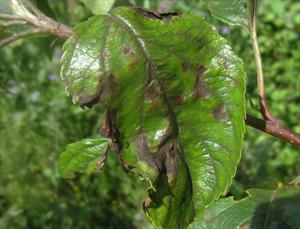 Scab on an apple leaf
Scab on an apple leafScab is a widespread fungal infection of apple trees, and to some extent pear trees. As with most fungal infections it is far more prevalent in areas with mild warm climates and plentiful rainfall. It is less of an issue in areas with dry climates.
Scab infection is generally not fatal, but it weakens the tree (because leaves are damaged). Scab also affects the fruit and makes it unsightly and unsaleable for commercial purposes, although for the home grower in most cases it is still usable (e.g. for juicing or cooking).
Infection arises from apple and pear trees in nearby gardens, and can happen at any time during the growing season. Infection is also possible from certain ornamental fruit trees such as Cotoneaster.
Development of scab-resistant apple varieties
Because scab is so serious for commercial growers, and has been around for centuries, there are many scab-resistant varieties available. These tend to be either old-fashioned varieties, selected over time because of their natural resistance, or modern varieties which have been bred with scab-resistance in mind.
It is worth noting that modern scab-resistant apple varieties are not genetically-modified (GMOs) as such. Rather they are the result of applying modern science to the centuries-old tradition of raising seedling trees from varieties which already have promising characteristics, and then progressively weeding out the ones that fail.
Modern development of scab-resistant apple varieties involves raising millions of seedling apple trees, but knowledge of the genes that confer scab-resistance means that identification of promising resistant varieties is more certain and a bit faster (although still taking many years). The pedigree of many modern scab-resistant apples often includes older varieties which have good natural resistance, such as the American culinary variety Rome Beauty, and the crab-apple Malus floribunda.
The first wave of scab-resistant varieties incorporated a single gene for scab-resistance, but newer varieties such as Honeycrisp incorporate multiple scab-resistant genes, to provide more wide-ranging resistance.
Apple varieties with some resistance to scab
Apple varieties with some susceptibility to scab
The famous English Cox's Orange Pippin is one of the most scab-prone apple varieties, and this characteristic is passed on to many of its offspring. However because scab is not usually a fatal disease, it is not always necessary to plant resistant varieties even if you live in an area where scab is prevalent - you can either just accept that some fruit may be "scabby". Whilst scab is very serious for commercial growers, for the gardener or small orchard owner, it is just a cosmetic problem.
Treatment
Scab used to be controlled with fungicidal sprays. These needed to be applied several times during the season, since scab spores are active throughout spring and summer. Unfortunately there are now no permitted treatments available to the amateur grower.
Good orchard hygiene is effective against scab, since the fungus overwinters in leaf-litter and rotten fruit. Clearing the orchard floor at the end of the season will prevent the infection re-emerging in the spring.
